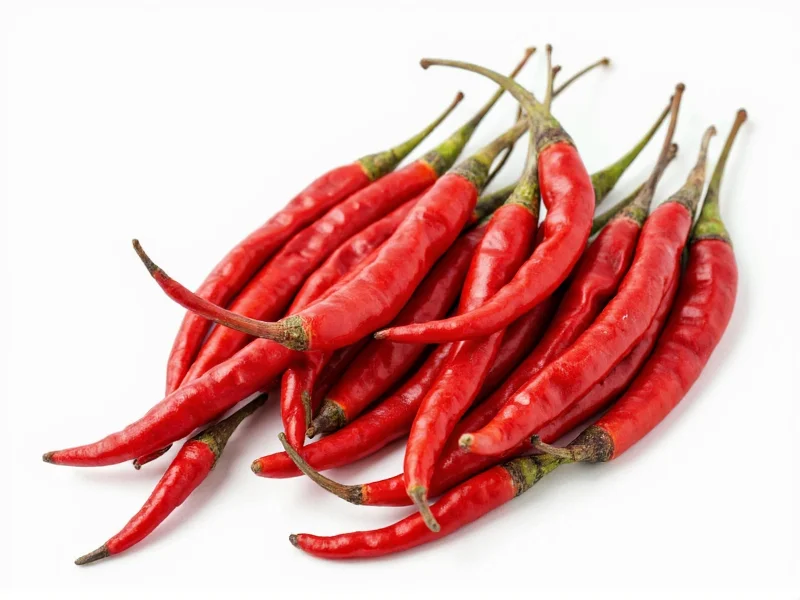Dry red chiles transform ordinary dishes into culinary masterpieces with their concentrated flavors and rich colors. Unlike fresh peppers, the drying process intensifies natural sugars while developing nuanced tasting notes that vary significantly between varieties. Understanding these differences is crucial for home cooks aiming to create authentic regional dishes.
Understanding Dry Red Chiles Varieties
Each type of dry red chile offers distinctive characteristics that influence both flavor and application. Recognizing these differences prevents recipe failures and helps you make informed substitutions when specific varieties aren't available.
| Chile Variety | Heat Level (Scoville) | Flavor Profile | Best Culinary Uses |
|---|---|---|---|
| Ancho (dried poblano) | 1,000-2,000 | Fruity, raisin-like, mild earthiness | Mole sauces, tamales, spice rubs |
| Guajillo | 2,500-5,000 | Tangy, berry-like, subtle heat | Adobo sauce, salsas, marinades |
| Pasilla (dried chilaca) | 1,000-2,500 | Prune-like, smoky, complex | Mole negro, soups, stews |
| Chipotle (dried, smoked jalapeño) | 2,500-8,000 | Smoky, spicy, bacon-like | Barbecue sauces, braises, bean dishes |
| Arbol | 15,000-30,000 | Sharp, nutty, intense heat | Salsas, vinegar infusions, finishing spice |
Proper Preparation Techniques
Correct preparation unlocks the full potential of dry red chiles while eliminating bitterness. The standard process involves three critical steps:
- Inspection: Examine chiles for mold or excessive brittleness. Discard any with dark spots or musty odors.
- Stemming and Seeding: Cut off stems and shake out seeds. For milder flavor, scrape out inner membranes where capsaicin concentrates.
- Rehydration: Place in a bowl, cover with boiling water, and weigh down with a plate. Soak 15-20 minutes until pliable but not mushy.
For deeper flavor development, toast chiles lightly in a dry skillet for 15-20 seconds per side before rehydrating. This technique enhances smoky notes but requires careful monitoring to prevent burning, which creates bitter compounds.
Storage Methods for Maximum Freshness
Dry red chiles maintain quality for 6-12 months when stored properly. Follow these guidelines:
- Store in airtight containers away from light and moisture
- Keep in a cool, dark pantry (not above the stove)
- For extended storage, freeze in vacuum-sealed bags
- Check periodically for moisture accumulation or mold
Whole chiles retain flavor longer than ground versions. When grinding your own chile powder, do so in small batches and use within 2-3 months for optimal flavor. Properly stored ancho chiles maintain their distinctive raisin-like notes significantly longer than thinner-skinned varieties like guajillo.
Substitution Guide for Common Recipes
When specific dry red chiles aren't available, strategic substitutions prevent recipe failure. Consider both heat level and flavor profile:
- Ancho substitute: Mulato (similar flavor, slightly sweeter) or New Mexico chile (less fruity, more earthy)
- Guajillo substitute: Cascabel (similar heat, nuttier flavor) or a blend of ancho and cayenne
- Pasilla substitute: Negro (similar depth, harder to find) or a mix of ancho and small amount of chipotle
- Chipotle substitute: Smoked paprika with cayenne (for smokiness without texture)
When substituting, adjust quantities based on heat differences. For example, replacing arbol with cayenne requires using half the amount due to cayenne's more concentrated heat.
Culinary Applications Across Cuisines
Dry red chiles form the backbone of numerous traditional dishes beyond Mexican cuisine. In Spanish cooking, ñora peppers flavor paella and romesco sauce. Turkish cuisine uses isot pepper for its distinctive dark color and mild heat in kebabs. Understanding regional applications expands your culinary repertoire while honoring authentic techniques.
For beginners working with dry red chiles for cooking, start with ancho-based mole poblano, which demonstrates how these ingredients create complex flavor layers. The process of toasting, rehydrating, and blending transforms simple ingredients into a sauce with remarkable depth that showcases why professional chefs prize these pantry staples.
Safety and Handling Considerations
While working with dry red chiles, follow these safety practices:
- Wear gloves when handling hotter varieties like arbol
- Avoid touching your face, especially eyes
- Wash hands thoroughly with soap after preparation
- Use separate cutting boards for chiles
- Work in well-ventilated areas when toasting
When adjusting heat levels in recipes using dried red chilies, remember that capsaicin dissolves in fat but not water. If you experience burning sensation, consume dairy products rather than drinking water.











 浙公网安备
33010002000092号
浙公网安备
33010002000092号 浙B2-20120091-4
浙B2-20120091-4